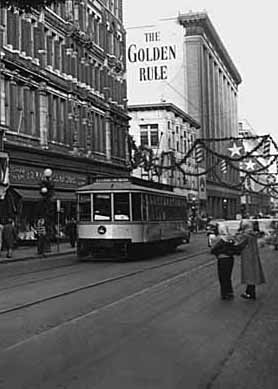Difference between revisions of "The Golden Rule/Emporium Department Stores"
(table) |
|||
| Line 13: | Line 13: | ||
Basement toilets were the most active places for queer male sexuality; men’s restrooms at the Golden Rule and Emporium (or Dayton’s and Donaldson’s in Minneapolis) were notorious in networks across the state, if not the nation. | Basement toilets were the most active places for queer male sexuality; men’s restrooms at the Golden Rule and Emporium (or Dayton’s and Donaldson’s in Minneapolis) were notorious in networks across the state, if not the nation. | ||
| − | | [[Image:Svc_emptea.jpg]] | + | |<div style="text-align: center;"> |
| + | [[Image:Svc_emptea.jpg]] | ||
| + | </div> <div style="text-align: center;"> | ||
| + | <small>'''The Emporium's basement Tea Room in 1937. "Tea Room" became synonymous with cruisy toilets by 1970, when Laud Humphrey wrote a shocking expose on the clandestine activity.'''</small> | ||
| + | </div> | ||
|} | |} | ||
| − | The Emporium was built six years before the Golden Rule in 1908. Located at the intersection of Seventh and Robert Streets, the two department stores competed for business at the busiest intersection of trolley lines in St. Paul. At the time, the stores sold everything from dresses to televisions to Christmas hams. The stores suffered with the development of suburban shopping centers and the downfall of the trolley system, and both stores closed in the late sixties. | + | {| {{prettytable}} |
| + | ! | ||
| + | ! | ||
| + | |- | ||
| + | |<div style="text-align: center;"> | ||
| + | [[Image:Svc_golden_rule.jpg]] | ||
| + | </div> <div style="text-align: center;"> | ||
| + | '''<small>The Golden Rule on Christmas Day in 1949.</small>''' | ||
| + | </div> | ||
| + | |The Emporium was built six years before the Golden Rule in 1908. Located at the intersection of Seventh and Robert Streets, the two department stores competed for business at the busiest intersection of trolley lines in St. Paul. At the time, the stores sold everything from dresses to televisions to Christmas hams. The stores suffered with the development of suburban shopping centers and the downfall of the trolley system, and both stores closed in the late sixties. | ||
| Line 24: | Line 37: | ||
Both buildings were retooled as office buildings, though the Emporium’s terra-cotta façade is presently covered by a modern glass veneer under the name of “Metro Square.” | Both buildings were retooled as office buildings, though the Emporium’s terra-cotta façade is presently covered by a modern glass veneer under the name of “Metro Square.” | ||
| + | |} | ||
Revision as of 11:57, 17 March 2010
At opposing corners on the north side of Robert Street and Seventh Street, St. Paul, MN
| Department stores are likely the longest-lasting queer sites in Twin Cities history. For most of the twentieth century, the impressive palaces of consumerism were places to see and be seen. Those appearing to be part of a upwardly-mobile class could (and still do) cruise for hours on the various floors under the guise of shopping for clothing and furniture.
|
The Emporium's basement Tea Room in 1937. "Tea Room" became synonymous with cruisy toilets by 1970, when Laud Humphrey wrote a shocking expose on the clandestine activity. |
| The Golden Rule on Christmas Day in 1949. |
The Emporium was built six years before the Golden Rule in 1908. Located at the intersection of Seventh and Robert Streets, the two department stores competed for business at the busiest intersection of trolley lines in St. Paul. At the time, the stores sold everything from dresses to televisions to Christmas hams. The stores suffered with the development of suburban shopping centers and the downfall of the trolley system, and both stores closed in the late sixties.
|
--This page is still under construction. -SVC
Part of Minneapolis/St. Paul, MN: 100 Queer Places in Minnesota History, (1860-1969), (1969-2010)

